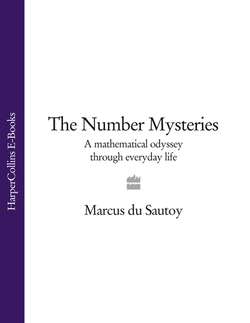Читать книгу The Number Mysteries: A Mathematical Odyssey through Everyday Life - Marcus Sautoy du - Страница 14
Which prime is this?
ОглавлениеFIGURE 1.08
This is how the Ancient Babylonians wrote the number 71. Like the Egyptian empire, the Babylonian empire was focused around a major river, the Euphrates. From 1800BC the Babylonians controlled much of modern Iraq, Iran and Syria. To expand and run their empire they became masters of managing and manipulating numbers. Records were kept on clay tablets, and scribes would use a wooden stick or stylus to make marks in the wet clay, which would then be dried. The tip of the stylus was wedge-shaped, or cuneiform—the name by which the Babylonian script is now known.
Around 2000BC the Babylonians became one of the first cultures to use the idea of a place-value number system. But instead of using powers of 10 like the Egyptians, the Babylonians developed a number system which worked in base 60. They had different combinations of symbols for all the numbers from 1 to 59, and when they reached 60 they started a new ‘sixties’ column to the left and recorded one lot of 60, in the same way that in the decimal system we place a 1 in the ‘tens’ column when the units column passes 9. So the prime number shown above consists of one lot of 60 together with the symbol for 11, making 71. The symbols for the numbers up to 59 do have some hidden appeal to the decimal system because the numbers from 1 to 9 are represented by horizontal lines, but then 10 is represented by the symbol (Figure 1.09).
FIGURE 1.09
The choice of base 60 is much more mathematically justified than the decimal system. It is a highly divisible number which makes it very powerful for doing calculations. For example, if I have 60 beans, I can divide them up in a multitude of different ways:
60=30×2=20×3=15×4=12×5=10×6
FIGURE 1.10 The different ways of dividing up 60 beans.
The Babylonians came close to discovering a very important number in mathematics: zero. If you wanted to write the prime number 3,607 in cuneiform, you had a problem. This is one lot of 3,600, or 60 squared, and 7 units, but if I write that down it could easily look like one lot of 60 and 7 units—still a prime, but not the prime I want. To get around this the Babylonians introduced a little symbol to denote that there were no 60s being counted in the 60s column. So 3,607 would be written as
How to count to 60 with your hands
We see many hangovers of the Babylonian base 60 today. There are 60 seconds in a minute, 60 minutes in an hour, 360=6×60 degrees in a circle. There is evidence that the Babylonians used their fingers to count to 60, in a quite sophisticated way.
Each finger is made up of three bones. There are four fingers on each hand, so with the thumb you can point to any one of 12 different bones. The left hand is used to count to 12. The four fingers on the right hand are then used to keep track of how many lots of 12 you’ve counted. In total you can count up to five lots of 12 (four lots of 12 on the right hand plus one lot of 12 counted on the left hand), so you can count up to 60.
For example, to indicate the prime number 29 you need to point to two lots of 12 on the right hand and then up to the fifth bone along on the left hand.
FIGURE 1.11
FIGURE 1.12
But they didn’t think of zero as a number in its own right. For them it was just a symbol used in the place-value system to denote the absence of certain powers of 60. Mathematics would have to wait another 2,700 years, until the seventh century AD, when the Indians introduced and investigated the properties of zero as a number. As well as developing a sophisticated way of writing numbers, the Babylonians are responsible for discovering the first method of solving quadratic equations, something every child is now taught at school. They also had the first inklings of Pythagoras’s theorem about right-angled triangles. But there is no evidence that the Babylonians appreciated the beauty of prime numbers.
